Explore the Unvisited La Mouzaïa District in Paris
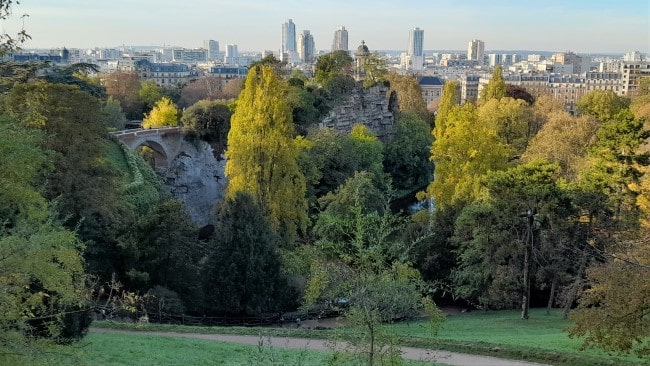
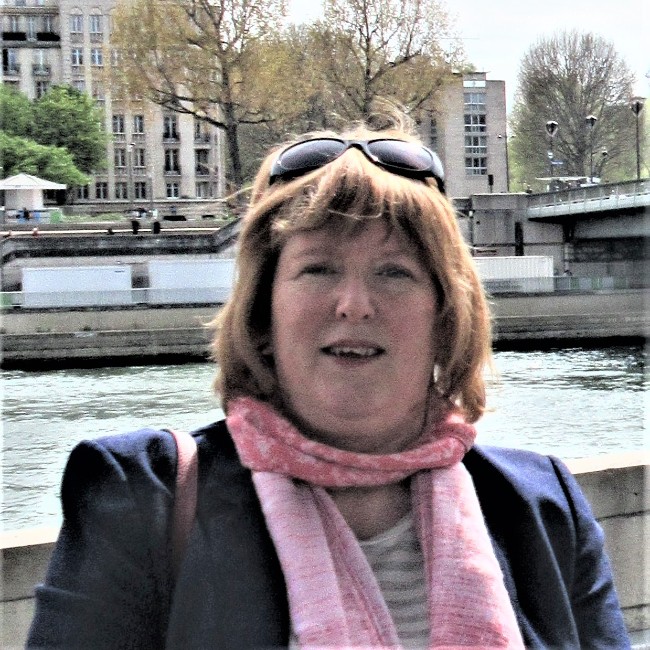
- SUBSCRIBE
- ALREADY SUBSCRIBED?
BECOME A BONJOUR PARIS MEMBER
Gain full access to our collection of over 5,000 articles and bring the City of Light into your life. Just 60 USD per year.
Find out why you should become a member here.
Sign in
Fill in your credentials below.
So, you’ve visited Paris several times now. You’ve “done” all the major sights: Eiffel Tower, Louvre, Musée d’Orsay. You may have gone a bit further afield and maybe explored Montparnasse or Batignolles. Or you just be feeling adventurous for your first visit. But one district that you quite likely don’t know is out in the 19th arrondissement, called La Mouzaïa. Close by is possibly the best park in Paris: the Buttes-Chaumont. In this article I am going to take you on an exploration of this delightful neighborhood high up in northeast Paris.
We start at the métro station Danube on Line 7bis. This odd little line is a loop whose only purpose seems to be to serve a handful of stations that would otherwise be disconnected from the main network. It is, however, easy to reach from Jaurès station (Lines 2 and 5) or Place des Fêtes (Line 11).
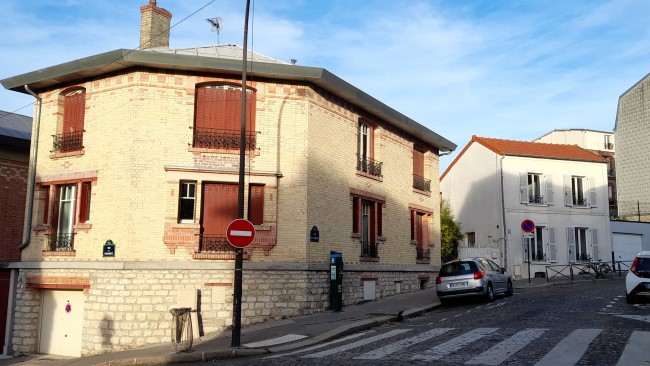
The corner of the Rue de la Fraternité and Rue de l’Egalité. © Pat Hallam
Taking the Rue David d’Angers away from the métro and almost immediately turning right into the Rue de la Fraternité, we are plunged into a very un-Parisian streetscape. No tall Haussmannian buildings here, because the whole area is built upon disused gypsum quarries. When the quarries closed towards the end of the 19th century and the land sold for redevelopment, the Ville de Paris stipulated that buildings should be only two storeys high, including the ground floor; the ground was too unstable for anything taller. (Only occasionally do you find a three-storey building.) The result is a distinctive network of small streets that have a provincial, decidedly un-Parisian air.
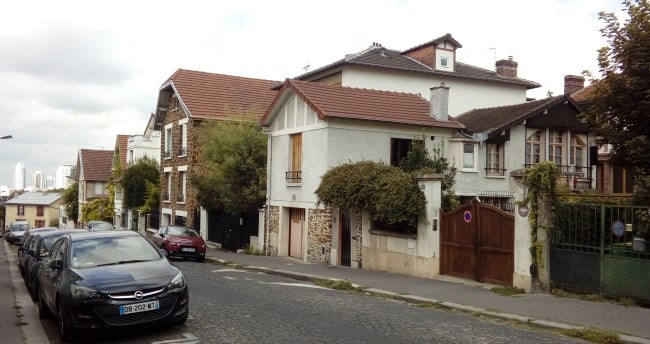
Rue de l’Egalité. © Pat Hallam
By the way, the gypsum was sold around the world, even to the White House, giving this area its other name: Quartier d’Amérique.
As we reach the top of Rue de la Fraternité it meets Rue de la Liberté and Rue de l’Égalité, which curves round to the left and we see the first of the “villas” that are a feature of this area.
Villa usually means a house, but in Paris it signifies a narrow, pedestrian lane. The “villas” in La Mouzaïa were deliberately planned to provide single houses for the quarry workers. Although intended for the working class, from the start La Mouzaïa was an early example of gentrification. Policymakers believed that enabling workers to buy their own homes would give them a greater stake in society and increase political stability. At this time the Third Republic was still in its infancy and there was a lot of political unrest. Small deposits and cheap mortgages allowed modest families to buy their own homes. Consequently, the residents of La Mouzaïa were already a cut above the vast majority of working-class Parisians who lived in cramped, unhealthy, rented apartments. The man who created property credit, Alexandre Ribot, is commemorated in the name of one of the villas.
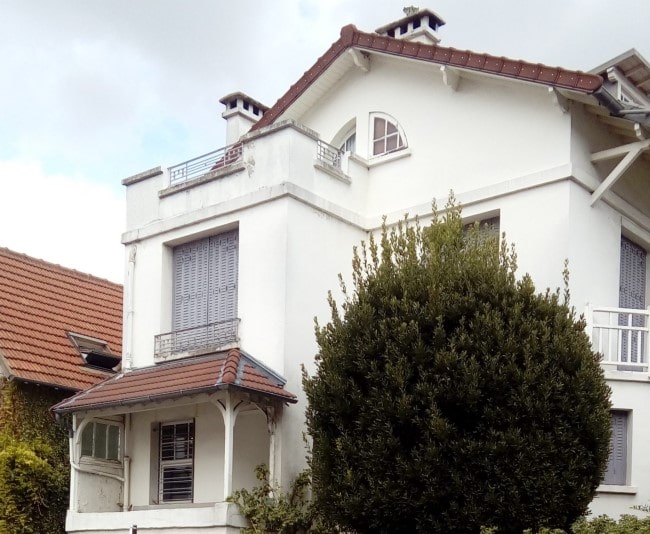
Rue de l’Egalité No. 3. © Pat Hallam
Some houses, such as those towards the end of Rue de l’Égalité, are spacious detached properties, but most are like those in the Villa de la Renaissance. The house on the corner sports bright turquoise shutters on white, and palm trees in the garden, giving it a colorful, Mediterranean air. As we walk up the lane, several houses are painted in pastel colors that bestow an almost seaside appearance. The houses here are smaller and built in a continuous terrace, each with a small front garden – almost unheard of in Paris! Some of these gardens are lovingly tended, with flowers in containers, trees and even small flower beds.
At the top of the Villa de la Renaissance, we arrive in one of the principal streets giving the neighborhood its name: the Rue de la Mouzaïa. It’s named after a hill in Algeria that was the site of a battle in 1840, when French forces were trying to conquer and colonize the country.
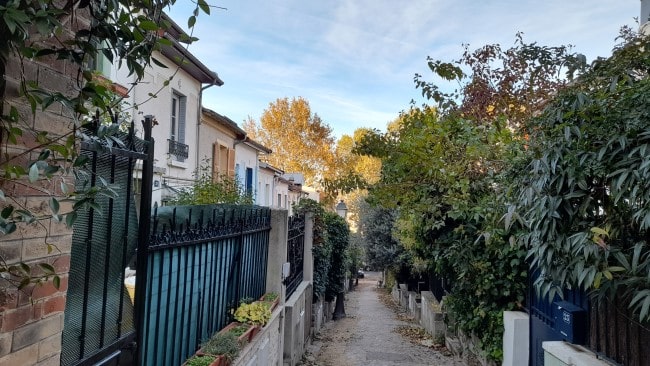
The Villa des Lilas. © Pat Hallam
We are now in the heart of the district. Turn right or left and we come to a succession of villas leading away from the street, but straight across the road is one of the prettiest, aptly named the Villa des Lilas. Mature trees and bushes overhang the wrought iron railings. In summer the scent of roses and jasmine fragrance the air, while in autumn, the leaves turn to vibrant shades of orange and brown. Concerted birdsong can be heard overhead in the trees. It is all very tranquil and village-like.
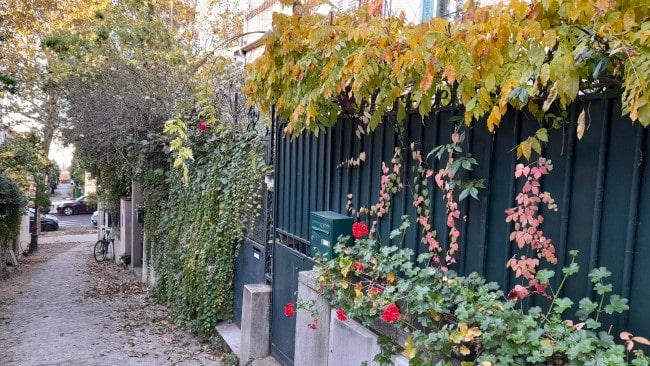
Autumn colour at the Villa des Lilas. © Pat Hallam
The villas are generally very quiet and it is a pleasant way to pass a sunny half hour exploring them. Several are named after prominent French politicians of the Belle Époque, such as Sadi Carnot, Félix Faure and Émile Loubet. Not to mention the trio of streets we saw named after France’s republican motto. There’s definitely a sense of social engineering going on. In some ways, La Mouzaïa recalls the Garden City movement in Britain of the same era, when model villages were built outside the big cities to provide hygienic, relatively spacious homes for working-class people.
Leaving the villas behind, we come out on to the Rue de Mouzaïa for the last time. At the bottom, where it converges with Rue Compans, it is only five minutes’ walk to Paris’s second-biggest park (and arguably the best).

View from Parc des Buttes-Chaumont. © Pat Hallam
We enter the Parc des Buttes-Chaumont near the Botzaris métro station and almost immediately we are greeted by a startlingly different, but still glorious, view of Paris. Owing to the park’s orientation, only Sacré Coeur, among the big sights, is visible. Instead, we have a wide panorama over the suburbs and out to the hills towards Chantilly. We get a real sense of Paris sitting in a basin surrounded by higher ground. And the fact that we are in a major world capital and can see open countryside on the horizon always lifts the spirit.

The view of Sacré Coeur as seen from the Parc des Buttes-Chaumont. © Pat Hallam
Like La Mouzaïa itself, the Parc des Buttes Chaumont is built over a gypsum quarry. When the quarry became exhausted in the 1860s, Napoleon III, who was a great fan of English parks, ordered it to be landscaped in the naturalistic English style. Hence the cascades flowing into a lake, the grotto and the replica Greek Temple de la Sibylle perched on its rocky outcrop. Two suspension bridges link different high-level paths. The steep slopes and paths on multiple levels afford a succession of views over Paris. Also, note the “log” steps and fencing. They look like well-weathered timber but, in fact, it is a clever use of concrete and they have always been like this. Overhead, green parakeets swoop and screech. Yes, parakeets in Paris. They have colonized every park and cemetery and don’t seem to mind the cold climate. You hear them constantly but they are quite elusive.
After so much walking, it is time to rest and refuel. The grassy slopes of Buttes Chaumont are a favorite with Parisians for summer picnics. So, bring a baguette, some cheese and charcuterie, and a bottle of wine. If you don’t fancy hauling that around, there are three café-restaurants in the park: Le Pavillon des Lacs, Rosa Bonheur and La Puebla. All three are very popular so grab a table and enjoy a well-earned drink after exploring this little-visited area of Paris.
Lead photo credit : The view from the Temple de la Sibylle in the Parc des Buttes-Chaumont. © Pat Hallam
More in La Villa, must-see, Paris day trips, parks



REPLY
REPLY